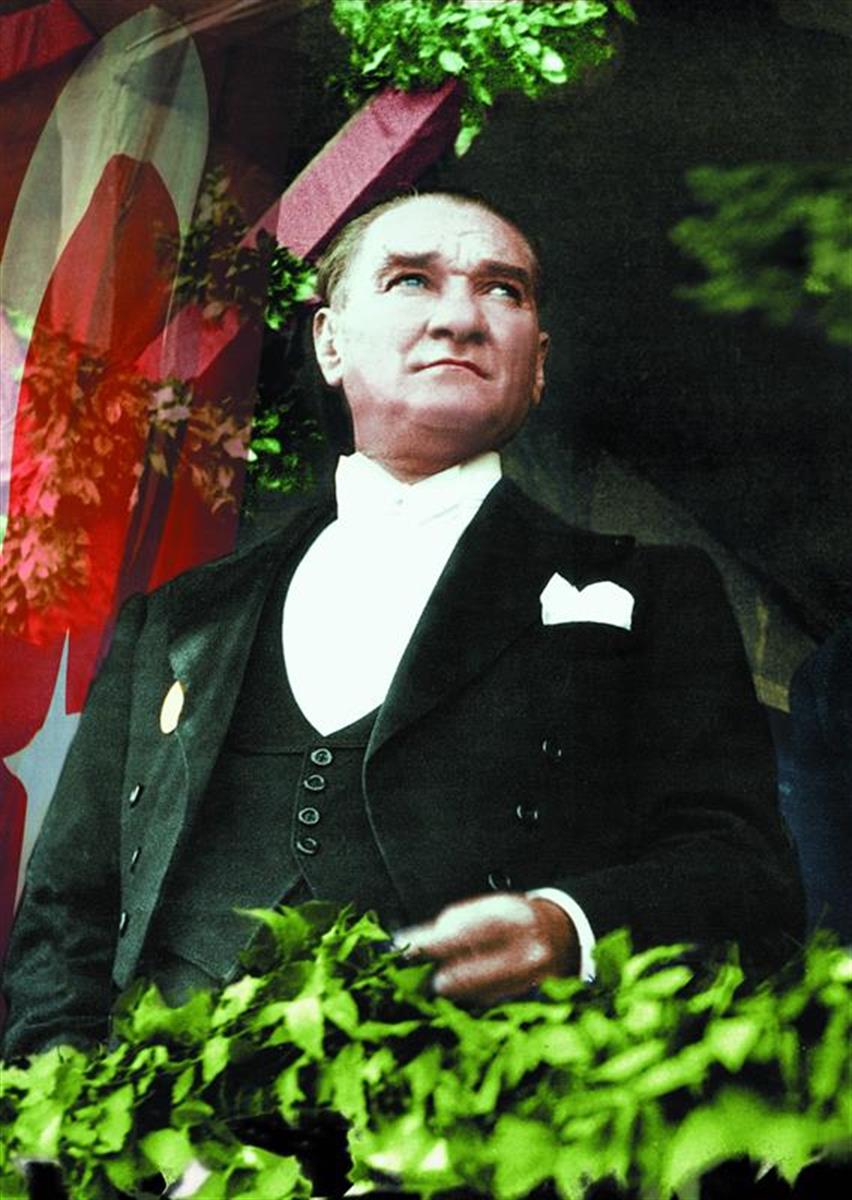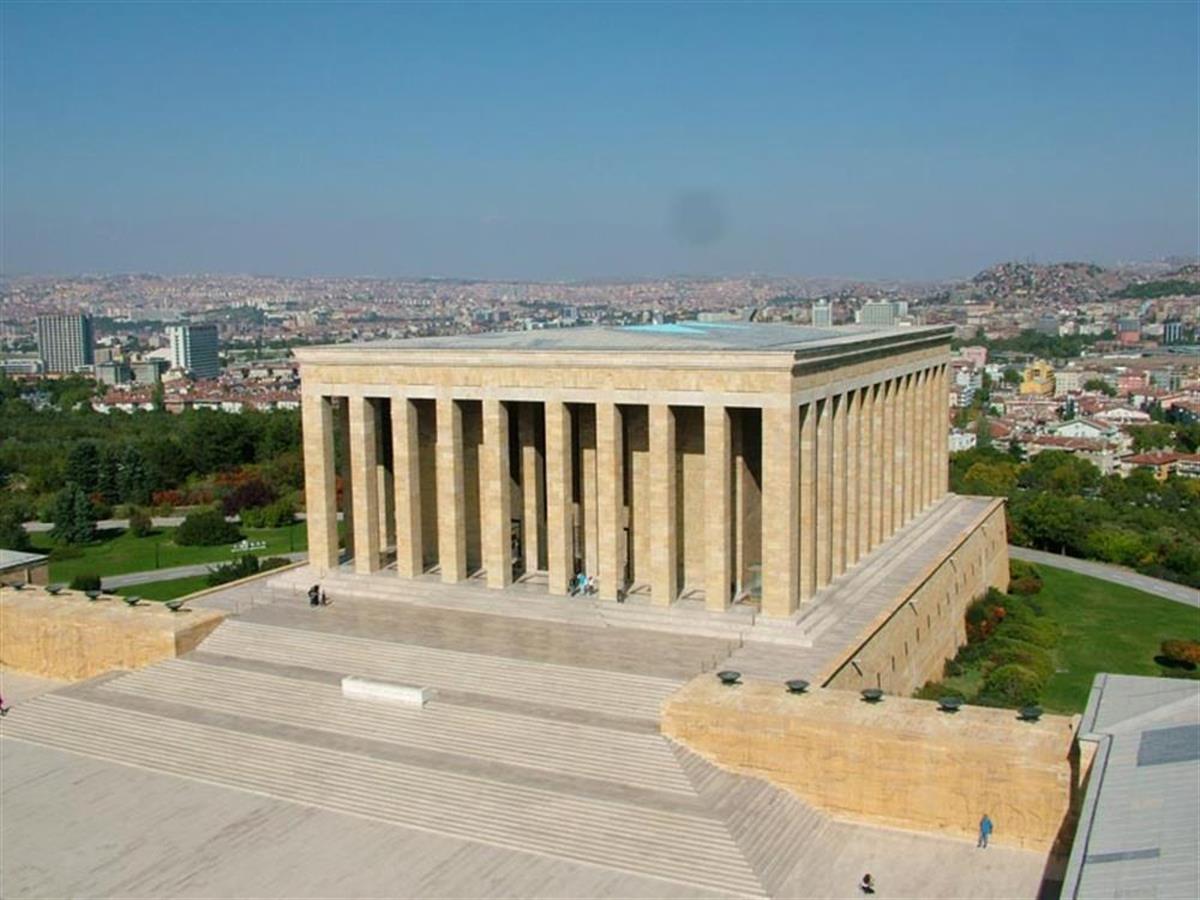Have you ever seen a graduation, a victory in a sports branch, or a Nobel Prize celebrated in a mausoleum? Or, have you seen wedding photos taken in a mausoleum and hung in the place of honor in houses? Well, if that mausoleum belongs to Atatürk, you can see it.
Atatürk is such a great founding leader for the Turkish people, that even though he passed away in 1938 at the age of only 57, his memory and presence are kept alive throughout the entire country.
Atatürk’s eternal resting place, Anıtkabir, is the heart of Ankara. It makes the city more meaningful. It is a frequent destination for local and foreign tourists not only on national holidays, but at every moment of the year. Anıtkabir is a place where people visit by expecting nothing in return. Even appearing before him in that atmosphere gives goosebumps. The love, appreciation, and longing for Atatürk is so profound that Anıtkabir is visited by millions of people every year.
So, who is this figure, Mustafa Kemal Atatürk, and why is he so important for the Turks?

Mustafa Kemal and His Importance for the Turks
Who is Mustafa Kemal Atatürk and why is he so important for Turkish people? First and foremost, Mustafa Kemal Atatürk is the founder and the first president of the Republic of Turkey. Considering the situation of the country at that time, the collapse of the Ottoman Empire, the efforts shown in the War of Independence, and the efforts to establish a republic, Atatürk stands out from other leaders. For Turkey, Mustafa Kemal Atatürk is a rebirth, the beginning of the republic, and an epoch. The country’s modern, progressive, and secular state, along with its current borders, are all thanks to him. For these reasons and many more, Mustafa Kemal is known as “Ata,” the father of the Turks, and the hero of the Turkish nation.
Atatürk, the namesake of many Mustafas living around the world, is not only the leader of the Turkish nation but also a global hero for his stance against colonialism.
A Leader, A Statesman, A Patriot
Mustafa was born in Thessaloniki, which was then within the Ottoman lands in 1881. In secondary school, his math teacher, whose name was also Mustafa, gave him a second name, ‘Kemal’ which means perfection and maturity. He did not know that he would change the fate of a nation when he graduated from the Military Academy, where he went with dreams of becoming a soldier. Starting his military career as a young officer during the collapse of the Ottoman Empire, it would become his identity, and he would serve as the commander-in-chief in our greatest war, the War of Independence.
Besides winning the war, there was a whole nation that had spent everything it had for independence—children orphaned, homes destroyed, lands barren, cities burned, but they resisted. As the Ottoman Empire, which had ruled over three continents for 622 years, was dissolving, this nation, which liberated itself from the occupying forces, would establish a republic on these lands freed from enemies thanks to Atatürk. This republic was founded on October 29, 1923, thanks to the great leader Mustafa Kemal Atatürk.
There was much work to be done. In the first presidential election following the declaration of the republic, Atatürk was elected president of the Republic of Turkey with a unanimous vote of all 158 members of parliament. He continued to lead the country until his death on November 10, 1938.
A Life Dedicated to a Country
On November 10th, at 9:05 in the morning, tragic news arrived. The unchanging law of nature for living beings implemented its ruling. Mustafa Kemal Atatürk passed away. On that day, an entire nation was left without its father. Atatürk’s body remained on a catafalque at Dolmabahçe Palace until November 19th. There was no one left in Istanbul who did not bid him farewell. There was a flood of people who wanted to see their ‘Ata’ for the last time. Everyone, local and foreign, was in mourning. Many countries around the world sent representatives to Atatürk’s funeral and expressed their condolences. Atatürk was not only a leader cherished by the Turkish nation, but also a very special figure recognized worldwide.
Atatürk stated in his will that the Turkish nation could bury him wherever they wished. However, everyone knew how special Ankara was to him and agreed that Atatürk’s eternal resting place should be in Ankara. Until the construction of his mausoleum, his body stayed at the Ankara Ethnography Museum.
The design and architecture of Anıtkabir were determined through an international project competition. It took about 9 years to build. Located at Rasattepe (now known as Anıttepe) in the Tandoğan district, Anıtkabir is situated in the heart of the city of Ankara. Tandoğan is one of Ankara’s most valuable neighborhoods because its residents are neighbors to Atatürk. Transportation to Anıtkabir is possible by subway, bus, and minibus. The mausoleum, located centrally in the city, is open every day of the week, including national and religious holidays, and admission is free.

Anıtkabir: Ata’s Tomb
Anıtkabir covers an area of 750,000 square meters. It has two entrances: one for pedestrians and another for vehicles where you can walk, park, or wait for shuttle services. The Road of Lions, the Ceremonial Plaza, the Hall of Honor (location of Atatürk’s tomb), and the Peace Park that surrounds the monument constitute the main parts. At the beginning of the Lion Road, there are the Towers of Liberty and Independence, with statues of men and women in front of these towers. Along both sides of the road, there are roses and junipers, and twelve lion statues are placed on each side of the road. According to a legend, the reason for the spaced stones is said to be for walking carefully and with bowed heads when approaching Atatürk’s resting place.
The ceremonial area, with a rectangular layout, is accessed via three steps. At the end of this path, on the right and left sides, there are the Mehmetçik (Turkish Soldier) and Müdafaa-i Hukuk (Defense of Rights) towers. Along with these ones, there are a total of 10 towers in the area. In the porticos surrounding the area, there is the Anıtkabir Command, the art gallery and library, the museum and the museum directorate. In the middle of the stairs, there is a podium for speeches and reliefs on both sides. In the section called the Hall of Honor, Atatürk’s symbolic cenotaph can be seen, but his actual tomb is located in the burial chamber underneath this part. Directly opposite the mausoleum, in the middle of the arcades surrounding the ceremony area, lies the tomb of İsmet İnönü, the second President of the Republic of Turkey and Atatürk’s comrade-in-arms.
A Temple Prepared to Commemorate and Preserve Him
Anıtkabir is not just a mausoleum but also a vast museum. It contains all kinds of information and documents related to Atatürk and the early years of the Republic. Atatürk’s library, the medals, and gifts he received, his clothes, his speeches in his own voice, and the stuffed body of his dog, Foks, are all housed here. It is also possible to access the history and contents of the wars in which Atatürk and his comrades-in-arms participated within the museum area. Panoramas of some battlefields, as well as portraits and paintings of Atatürk, are also located in the Atatürk and War of Independence Museum area within Anıtkabir.
The soldiers who stand guard for an hour without moving impress visitors to Anıtkabir, especially with their unique performance during the changing of the guard. The soldiers who guard Atatürk undergo intensive training and are specially selected. This privileged duty makes them feel special for the rest of their lives.
Commemorating Atatürk: Not Just One Day, But Every Day
Atatürk died as a leader who loved the Turkish nation and every inch of its land. For this reason, the burial chamber contains soil brought from 81 provinces of Turkey, the Turkish Republic of Northern Cyprus and Azerbaijan and kept in special brass vases.
Anıtkabir, the most important symbol of the modern Republic of Turkey, hosts every significant ceremony in the country. Turkey has four holidays declared by Atatürk: April 23, National Sovereignty and Children’s Day; May 19, Commemoration of Atatürk, Youth and Sports Day; August 30, Victory Day; and October 29, Republic Day.
Anıtkabir visiting hours are set from 09:00 to 17:00 (subject to change depending on the season), but it is open until 22:00 on national holidays. On national holidays, after the state ceremony, the mausoleum begins to accept visitors from 11:00, hosting millions, especially on these days. Besides these days, there is another special day for Turks to commemorate Atatürk: November 10.
The One Minute When Life Stops
Even though 86 years have passed, life in Turkey comes to a standstill every November 10th at 09:05. Sirens start to wail. Everyone walking on the road, in class, or at work stands to attention. Cars stop, drivers get out of their vehicles, and stand at attention. Every year, Turkey halts life for one minute in honor of Atatürk and continues to remember him.
If you are a foreigner visiting Turkey and find yourself surrounded by flags, see everyone dressed in red and white, notice crowds of people heading in one direction on metros and buses, or hear sirens ringing in the morning and see everyone standing still, then you can be sure that the calendars are marking one of Turkey’s important national days.
Anıtkabir is not just visited during national holidays; schools from all over the country come to visit throughout the year. Students come to pay their respects to Atatürk during their graduations, newborn babies are brought to Atatürk, and couples getting married or wanting to take commemorative photos often visit. Anıtkabir is the first place to go for everyone who visits Ankara. It’s not only a point of interest for Turks but also a subject of curiosity for foreigners, who are intrigued by Atatürk’s path, achievements, and principles.
It should never be forgotten that Turkey exists thanks to Mustafa Kemal Atatürk. This country will always be grateful to him.
